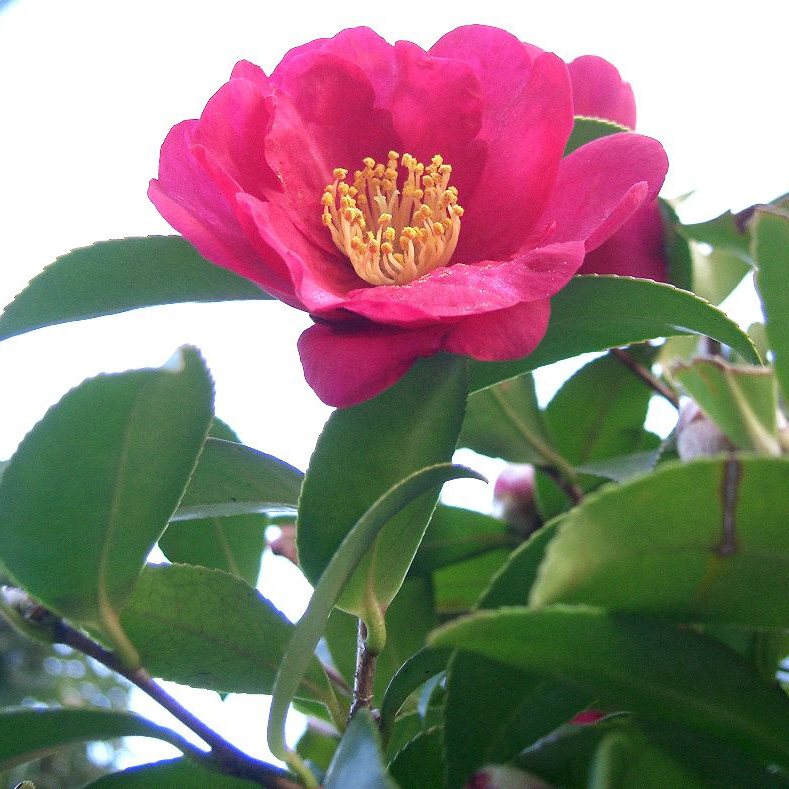Camellia sasanqua*
Camellia sasanqua 'Yuletide'**
Camellia sasanqua***
I recently read an eye-opening article on Gene Phillips's lifelong garden pursuit at Magnolia Plantation. I was especially impressed with his conversion to a more naturalistic gardening style and his passion for Camellias. To read the article, click here.
In their native region of eastern Asia, some Camellias are cultivated for practical reasons such as tea consumption and oil production. But here in the South, Camellias are grown for their beautiful winter blooms and the wonderful evergreen addition that they add to the landscape, primarily as individual specimens. Below are some tips to grow happy, healthy Camellias.
First and foremost, choose a variety that is hardy to your zone. I cannot stress this enough. For the most part, C. sasanqua are hardy here in middle Tennessee. Some of the cultivars of C. sasanqua I recommend are 'Cleopatra', 'Kanjiro', 'Londontowne Blush', 'Northern Exposure' and 'Yuletide'.
Plant Camellias from late fall to early spring, but don't plant when the ground is frozen. The soil should be organically rich and well drained. Avoid any areas near shallow rooted shade trees; those roots compete for essential water and nutrients. Camellias need slightly acidic soil - ideally 6.0 - 6.5. A soil test may be necessary to ensure proper pH.
Water is essential, especially when plants are first planted. Once plants are established, continue to water so that soil is moist 14 to 18 inches deep. Mulching with an organic, acidic material such as pine straw to a depth of 2 to 4 inches is also beneficial.
Fertilizing is essential to ensure the health of your Camellias. For best results, use a slow release fertilizer in three applications throughout the growing season. For our area, it is suggested to fertilize in early March, early May and early July. I prefer a slow release, organic based fertilizer that includes micronutrients and soil acidifiers.
Any significant or major pruning should be done during the winter or early spring. However, pruning to maintain form can be performed throughout the year.
Pests and problems for Camellias include aphids, canker and dieback, root rot and tea scale. For information on how to treat these or any other problems you may encounter, click here.
For much more information about Camellias, visit the American Camellia Society online. If you are ever in Georgia, you should visit the Massee Lane Gardens, which houses the American Camellia Society's Camellia collection. One of my personal favorite places to see Camellias in a naturalistic planting is in St. Francisville, Louisiana, at Rosedown Plantation.
On April 10, 2015, I will lead an eight day riverboat tour aboard the American Queen. On this 'Gardens of the River' tour, we will have stops in Memphis, Tennessee; Vicksburg and Natchez, Mississippi; and will make a special visit to St. Francisville. Join us if you are interested in experiencing some great gardens.
Interested in adding Camellias to your landscape or the 'Gardens of the River' tour, contact me at justinstelter@gmail.com.
* image used under Creative Commons License. Source file: https://commons.wikimedia.org/wiki/File:Camellia_sasanqua_RJB.jpg
** image used under Creative Commons License. Source file: https://commons.wikimedia.org/wiki/File:Camellia_sasanqua1.jpg
*** image used under Creative Commons License. Source File: http://commons.wikimedia.org/wiki/File:Camellia_sasanqua.jpg




